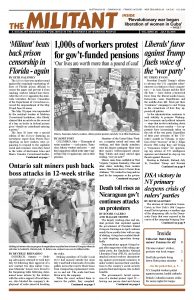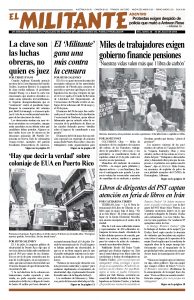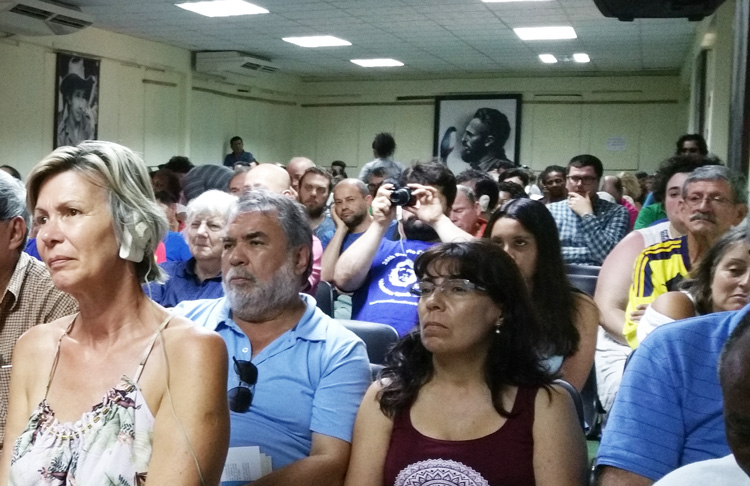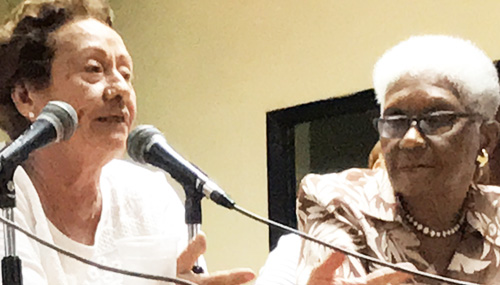HAVANA — One of the high points for participants in the International May Day Brigade to Cuba this spring was having the opportunity to hear from some of the combatants who took part in the revolutionary war there. Led by Fidel Castro, the revolution overturned the U.S.-backed dictatorship of Fulgencio Batista in 1959 and brought Cuba’s workers and farmers to power.
We heard from Teté Puebla, Pérsida Chibás Ponce, Rogelio Acevedo and others, who told us how and why they joined the fight for a revolution that won against seemingly impossible odds, and about how they themselves — then in their teens — were deeply transformed as human beings through their experience in that struggle.
Pérsida Chibás Ponce was one of the scores of women who joined the Rebel Army. As a black, 15-year-old girl, Chibás told us, she was already aware that women’s oppression was tied to class and race. She described how the Rebel Army even before ousting the dictatorship began transforming relations in the areas under its control, including measures to overcome divisions among working people. Under Raúl Castro’s leadership in the Second Front in Eastern Oriente province, she helped establish schools for the growing number of peasants — many of them illiterate — joining the rebel fight.
After she had been in the Sierra for some time, and had several promotions as a fighter, someone asked her how it felt to be the only black woman combatant with her high rank. “I suddenly realized then that I had stopped being aware of those differences,” Chibás said, “and that made me conscious of how the divisions of class and race had been transcended, for me, in the process of the struggle.”
With the 1959 triumph of the revolution, the new government led the fight that eradicated all forms of legal racial discrimination, which from the start had been an integral part of the July 26 Movement’s program. The revolutionary changes in Cuba guaranteed equal access for blacks to education, work, health, culture and sports, as well as representation in the country’s political and legislative structures, she said.
“But we have to remain fully conscious that discrimination can’t be eliminated by decree alone,” said Chibás. “Struggle against it must never cease.”
After the victory over Batista’s forces, Chibás left the Rebel Army and became active in the volunteer militias and other tasks of the revolution. In 1971 she joined the Revolutionary Armed Forces, eventually achieving the rank of lieutenant colonel. In 1986 she was part of Cuba’s internationalist mission in Ethiopia and later was one of more than 420,000 Cubans who went to Angola as volunteer combatants to help defeat the invasions by the South African apartheid army.
Chibás told us that revolutionary leaders Fidel Castro and Vilma Espín led the fight for full participation of women, which included the establishment of the Federation of Cuban Women one year after the revolution came to power.
Cuban women fight for revolution
Cuban women have won election to all levels of government, the passage of laws guaranteeing equality with men, the right to abortion and have gained more control over all aspects of their lives.
“The revolutionary war was the beginning of the liberation of women,” said Teté Puebla, who joined the rebels in Sierra in 1957 at age 16. She said she claimed to be a year older, “so I would be allowed to stay.” Puebla explained she came from a peasant family in Granma province.
Puebla is now a brigadier general in Cuba’s Revolutionary Armed Forces — the highest-ranking woman in Cuba’s army — and a deputy to Cuba’s National Assembly. She recounted how despite sharing a common cause, facing a common enemy and living under the same harsh conditions in the Sierra, it was still a fight to overcome the prejudices ingrained even in some of the best of the male fighters.
Because of the resistance from some men in the rebel forces to women’s insistence that they shoulder the same responsibilities, Puebla said, Fidel Castro decided that not only were the women to become active combatants, but he organized the special Mariana Grajales Women’s Platoon. He appointed Puebla as second in command.
When men complained that the scarce weapons were being “wasted” on women, Castro replied they were given guns because “the women will prove to be better fighters than all of you.” She said Fidel later told the women, “You better not make me look bad, after this!” and then assigned himself to give them intensive training in weapons use.
The full story is told in Marianas in Combat: Teté Puebla & the Mariana Grajales Women’s Platoon in Cuba’s Revolutionary War 1956-58 written by Puebla and published by Pathfinder Press.
They didn’t make Castro look bad. The exemplary courage and discipline the Mariana Grajales Women’s Platoon displayed in battle proved right Castro’s full confidence in the women. They, in turn, went on “from that platoon in the Sierra Maestra to today’s full participation of women in all tasks related to defense,” Puebla said. “We are the Revolutionary Armed Forces of Cuba.”
Today Cuban women make up 60 percent of all university graduates, and 78 percent of health professionals. “Without the revolution, women would never have reached the conditions we enjoy today,” Chibás said.
After the revolutionary victory, Puebla helped recruit peasant women to attend the Ana Betancourt School in Havana. There they went through all the regular school curriculum, and also received training in various vocational trades.
After hearing these presentations, some brigade members asked what advice the veteran combatants had for their efforts to make changes back home in their own countries, including how to fight racist and sexist oppression. There has to be a fight, and there has to be a revolution, Chibás said, there is no other way.
“But there are no recipes,” she added. “Do your own revolution. It has to come from you.”



